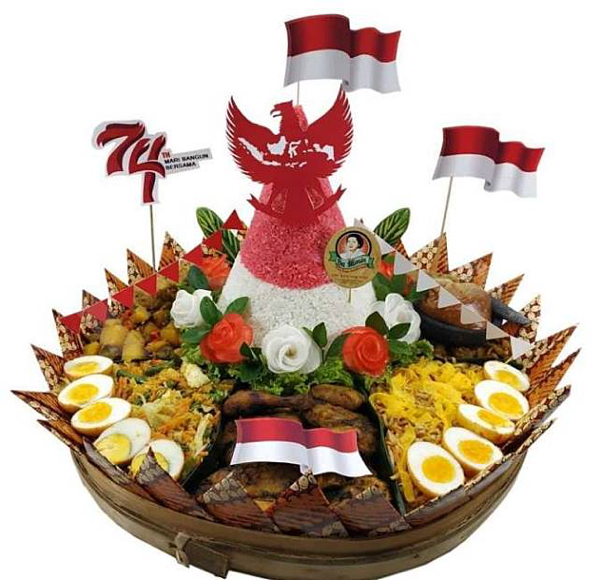Sustainability Sparks Breakthrough Action at the Green Event

By Neng Vivie Nurfauziaah Rukmini
‘Nasi Tumpeng’ since 2012 has been legalized as an Indonesian Culinary icon by the Minister of Tourism and Creative Economy, Mari Elka Pangestu in order to present the culinary riches that exist in Indonesia and it is highly recommended to always be served at events of an international nature to promote Indonesia’s distinctive characteristics. According to Murdijati Gardjto and Lilly T. Erwin (8:2010), ‘nasi tumpeng’ is yellow rice in the shape of a cone and in general the cone height is bigger than the diameter of the circle of the cone base which is then decorated with various side sidhes around it, ranging from chicken, cakes, eggs, omelette, tempeh, and of course ‘sambal’ in a place (large, round, woven bamboo tray).
This ‘nasi tumpeng’ is made from rice with coconut milk and spices, then steamed whe cooked, the color will turn golden yellow (golden) and shaped like a mountain using a tool called ‘aseupan’. The philosophy of Nasi Tumpeng, which is golden yellow in color, symbolizes greatness and is a symbol of offerings of respect to the Almighty. The cone shape points upwards to the Creator, that is God. Arround the ‘Nasi Tumpeng’, a minimum of seven kinds of side dishes are arranged, because the number seven in Javanese is ‘pitu’ and has an acronym with ‘pitulungan’ which means that humans must live and help each other (Kumayroh, 2013).
The presentation of ‘Nasi Tumpeng’ begins with the habits of the Javanese, Balinese and Madurese people which are often served at large and sacred events, such as festivals or traditional ceremonies. According to the community, the cone shape facing upwards is likened to Mount Mahameru, wherethis place has its own history, namely a place that is glorified as the dwelling place of the ancestors.
At the time of the procession of eating together, the first thing to cut is the top or top and then throw it on the roof to get a blessing or ‘berkah’. Apart from that, there is also a tradition of giving the top of ‘nasi tumpeng’ to respected people so that the first gift is given to him out of respect for someone who is older. The completeness of ‘nasi tumpeng’ is means for humans to ask for protection, safety, welfare, or convey the intention to the environment which is hoped to be put accordingly in the presentation of ‘nasi tumpeng’.
The history and philosophy taken from ‘nasi tumpeng’ is characteristic of the Indonesian nation that we need to be proud of and introduce to the whole world community, that Indonesia has its own history. ‘Nasi Tumpeng’ also should be presented at certain events to introduce one of Indonesia’s food icons.
Recently, reported from kemlu.go.id, on Tuesday, February 23, 2021, the Indonesian Consulate General in Cape Town, South Africa carried out a promotional activity for Indonesian culinary culture at Wisma Indonesi, with the event entitled “Nasi Tumpeng: a Traditional Indonesia Dish”. This event in collaboration with the Dharma Wanita Persatuan KJRI Cape Town, and the participants are thirteen women from various countries who are members of the International Women’s Club (IWC) Cape Town or an organization which is a non-profit association established with the aim of learning from each other and fostering understanding cultural differences based on the value of friendship, mutual support and fun. At the end of the event, the President of IWC, Mrs. Amanda Osorio says “ A such beautiful, lovely, and memorized event. I like this ‘nasi tumpeng’ so much”.
In addition, such as in the celebration of the 70th anniversary of diplomatic relations between Indonesia and America in 2019 which was celebrated lively, and in that event also introduced the tradition of cutting tumpeng because the relationship between the two has achieved success in the fields of politics, economy, security, environment, and education. This is a form of gratitude for the establishment of good relations between them. In the event session also, the top of ‘nasi tumpeng’ was given to Mr. Garret MacDonalds as the US Embassy agricultural and trade attache.
From that event, we hope ‘nasi tumpeng’ can always be served in every international activity so that the world community will get to know the characteristics of Indonesia, especially in food culinary.
Sources
- https://www.researchgate.net/publication/265857830_Local_wisdom_behind_Tumpeng_as_an_icon_of_Indonesian_traditional_cuisine
- https://www.academia.edu/31453007/Pergeseran_Makna_Sakral_dan_Fungsi_Tumpeng_di_Era_Globalisasi
- https://kemlu.go.id/capetown/id/news/11270/diplomasi-nasi-tumpeng-untuk-diaspora-dunia
- https://old.kemenparekraf.go.id/post/diplomasi-rasa-mempromosikan-indonesia-melalui-kuliner
- https://food.detik.com/berita-boga/d-4626841/tumpeng-tandai-70-tahun-hubungan-diplomatik-indonesia-dan-amerika.
Writer’s Bio
 Neng Vivie Nurfauziaah Rukmini, one of the Budget and Public Affairs team in IYF. Usually caled as Nurfa or Vivi, she’s very interesting about sosial environment, politic, religion, education, business and developing start up at Ruang Limbah and soci0waste. Currently she is a student of Political Sciences in State Islamic University Bandung. She loves to inspire and be inspired many people and always wants to be surrounded with positive vibes.
Neng Vivie Nurfauziaah Rukmini, one of the Budget and Public Affairs team in IYF. Usually caled as Nurfa or Vivi, she’s very interesting about sosial environment, politic, religion, education, business and developing start up at Ruang Limbah and soci0waste. Currently she is a student of Political Sciences in State Islamic University Bandung. She loves to inspire and be inspired many people and always wants to be surrounded with positive vibes.








